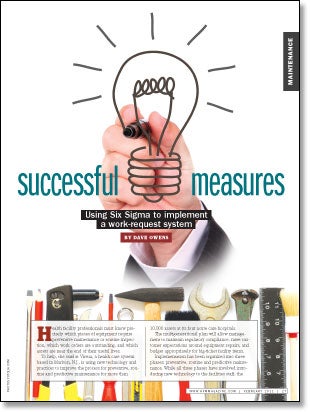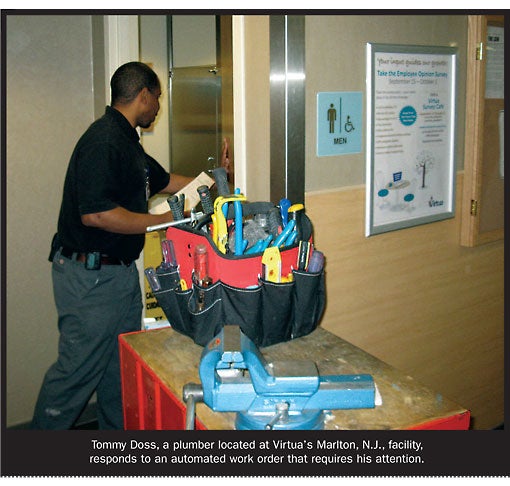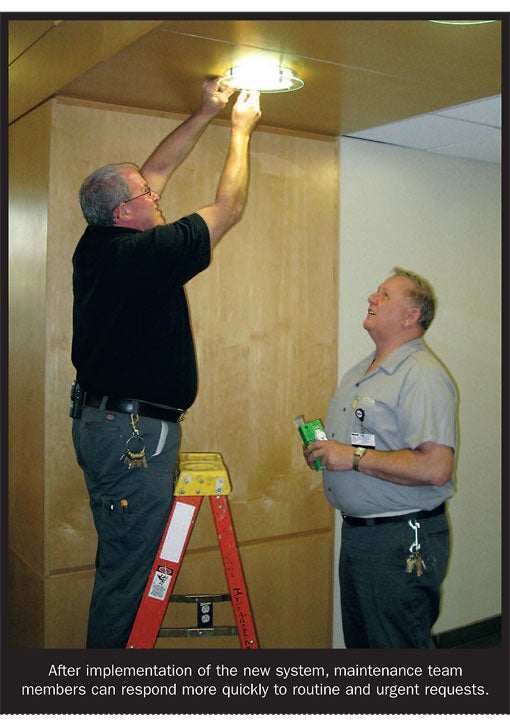Successful measures
 Health facility professionals must know precisely which pieces of equipment require preventive maintenance or routine inspection, which work orders are outstanding, and which assets are near the end of their useful lives.
Health facility professionals must know precisely which pieces of equipment require preventive maintenance or routine inspection, which work orders are outstanding, and which assets are near the end of their useful lives.
To help, the staff at Virtua, a health care system based in Marlton, N.J., is using new technology and practices to improve the process for preventive, routine and predictive maintenance for more than 10,000 assets at its four acute care hospitals.
The multigenerational plan will allow management to maintain regulatory compliance, meet customer expectations around equipment repairs, and budget appropriately for big-ticket facility items.
Implementation has been organized into three phases: preventive, routine and predictive maintenance. While all three phases have involved introducing new technology to the facilities staff, the
routine-maintenance phase has involved introducing a new electronic work order-request system to Virtua's more than 8,000 employees and, most importantly, getting them to use it.
A broken system
It was clear that the existing maintenance-request process was broken. Placing requests was complicated and inconsistent because there were so many different ways to do it — phone, email, pager, log book or "tell the facilities staff." In addition, staff spent a great deal of time managing and delegating requests, investigating and responding to complaints and tracking open work orders.
The manual nature of the process made metrics for key indicators difficult to collect and compare across divisions. From an internal customer's perspective, the process was inefficient and a burden. A nursing leader's feedback summed up the general attitude about the process. She said it was difficult for staff to place a request; it was hard to follow up on a request once one was placed; it seemed to take days to complete a request; and multiple requests sometimes were required for the same issue.
The maintenance initiative focused on designing a process that streamlined routine work order submissions for requests such as clogged toilets, stained ceiling tiles, broken equipment and even project work (e.g., painting and renovations).
Management recognized that improving routine maintenance would involve changing not only the technical process of submitting requests but also the behavior of thousands of staff. They chose design for Six Sigma (DFSS) tools and methodology so they could include staff in the process of creating and implementing the standardized, enterprisewide routine maintenance program.
Major DFSS steps
The five major DFSS steps — define, measure, analyze, design and verify — were applied to the project in the following ways:
Defining the challenge. The first phase of the DFSS process focused on building a team and defining the project. The project was sponsored by a hospital chief operating officer and the vice president for support services. The team consisted of facilities directors, operations directors, the system safety director, IT business analysts, human resources, an HVAC vendor and facilities staff.

Three of the team's initial tasks included identifying industry best practices, scoping the project and assessing challenges they needed to address. The team conducted a comparative analysis to identify best practices from organizations both within and outside the industry, including process strengths, requirements and lessons learned. The scope included equipment already supported by facilities management at the organization's four acute care facilities and one of the system's ambulatory-based facilities.
The team identified two major challenges — managing change and accounting for the differing levels of clerical support staff within the facilities department at each hospital. The team identified key stakeholders at each location and tried to assess their potential resistance to change. While most stakeholders were not opposed to change, the team learned they would have to help move the primary customers (i.e., clinical and non-clinical staff, and physicians) to a more supportive mindset. Regarding clerical staffing levels, the team was concerned that people would be less likely to submit a routine request electronically and more likely to continue calling clerical staff within the facilities department to verbally place a request. The team decided to take a wait-and-see approach to this issue. If the use of clerical staff impacted the adoption rate, the team would develop corrective action.
Measuring customer needs. The next phase consisted of identifying the customers' needs and deciding which metrics were deemed critical to quality.
The team developed a survey with five questions focused on timeliness, notification preferences and communication around delays. The results showed that at least 65 percent of customers preferred to submit requests and receive updates electronically. In addition, customers working in patient care areas wanted a time-sensitive mechanism they could use when an urgent or a patient-related request needed attention.
Analyzing and designing. In the analyze and design phases, the DFSS team created process maps to show each step in the new routine. The goal was to set up a process that incorporated customers' expectations and was efficient for the facility staff.
The team focused on developing a process that provided an electronic method for routine requests, included a method for placing expedited urgent requests and integrated an electronic feedback mechanism.
The team spent a day designing the new process, which allowed customers to submit routine requests via Virtua's intranet and submit urgent requests by phone to a facility staff member who then would enter the request into the system elecÂtronically and address it immediately.
The team decided to pilot the plan enterprisewide instead of at one facility because the electronic requests would be initiated from Virtua's systemwide intranet. Also, starting the pilot systemwide would reduce confusion among front-line staff, especially those who travelled between facilities.
The team created a scorecard to determine effectiveness of the new process and gauge the success of the pilot. Metrics included the percentage of requests made by Web versus phone, the time it took to acknowledge a request, and the timeliness of work completion. A communication plan was developed to educate stakeholders across all facilities. It included educating staff at manager meetings, distributing weekly notices and instructions in organizationwide electronic newsletters, conducting department rounds, making presentations at town hall meetings and putting placards in all cafeterias leading up to the change.
The pilot lasted four weeks. Initially, 54 percent of routine-maintenance requests were made electronically, far short of the team's goal of 80 percent and an indication that the process was not hardwired.
Additional analysis showed that the electronic method was adopted more slowly in facilities with more clerical support within the facilities department. So, when a nonurgent request was phoned in, the facilities staff captured the request, entered it electronically, educated the caller about the new system and encouraged the caller to use it.

During the pilot, 100 percent of requests were acknowledged within 45 minutes. This performance met the customer's expectation. In fact, because the system was electronic, the person making a request received immediate confirmation of the submission and information about tracking its progress. With respect to timeliness, 81 percent of the work orders opened were closed during the four-week pilot. This surpassed the goal of closing 80 percent of work orders within 30 days.
Managing mixed results. When a DFSS project comes to a close, a control plan is put in place to monitor and hardwire the new process. In the case of this project, the control plan included standard reports that are reviewed and acted upon monthly by the facilities council (consisting of the vice president for support services, the system safety director and facility directors from all campuses).
A follow-up was conducted to determine the sustainability of the pilot results. Between May 2009 and February 2010, more than 18,500 routine-maintenance requests were placed across the system. The acknowledgment- and work order-completion targets for these requests were achieved. However, use of the Web-based system for routine requests significantly lagged the target.
The team scrutinized data and observed that the lowest utilization rate was at the organization's ambulatory center. The most likely reason was because the majority of the building's occupants are non-Virtua employees in office space rented by health care-based community organizations. Although a portal was built for this group to allow access to the system, adoption has been slow.
The two largest facilities — the ones with the most clerical staff in the facilities departments — displayed the next lowest utilization rates. The team spoke with employees there and found they continued to ask facilities staff to place routine requests instead of entering them electronically simply because staff were readily available.
The team also learned that another factor contributing to the low electronic-submission rates was the way environment of care (EC) rounds were documented. These monthly safety rounds are completed by a representative from each department who submits routine-request work orders via paper to the facilities staff, leaving a facilities clerical staff member to enter the information electronically into the new system.
As a result, the team will be implementing a way for the department safety representatives to capture the EC information electronically and submit it to the routine-maintenance request system via an electronic work order.
In addition, the team is working with the maintenance-request system's administrator to create an automatically generated report that the administrator and the project sponsors can use to monitor the electronic request rate real-time. Furthermore, the team is studying the facility with the highest utilization rate to replicate the best practice that is present there.
Keys to success
The control phase of the project continues as the team works to build on the project's overall successes. Several key factors have made the system viable and revealed opportunities for improvement.
First, the project received support at all levels of the organization. Second, the representatives from facilities management were very committed to the success of the new process. Third, information technology support was critical. And, finally, the DFSS methodology provided the structure needed to build standardization and implement process change across the organization.
After implementation of the new process, the facilities team and customers noted significant benefits.
"The new system has had multiple benefits," says Rick Houck, director of plant engineering at Virtua's Marlton, N.J., facility. "Because the previous process was manual and had multiple inputs, we were challenged by how quickly we could complete requests. Now my team can complete requests in two hours because we have a consistent way of receiving them."
Houck adds that the new system allows him to shift staff between projects and routine-maintenance work, depending on the current needs of his customers.
The ability to track and trend complaints also has improved. "We are now able to tell when, and if, a work order was placed and can work with our employees to make sure that everyone follows the correct process to place a work order," Houck says. "In addition, the ability for our system to 'close the loop' with the customer has proven to be beneficial as customers don't have to wonder if their request was completed. They know exactly when it was done."
Customer focus
Preventive maintenance, routine work-order requests and predictive maintenance can be streamlined through the use of new technology, but these software packages are hardly "plug-and-play."
Rather, new technology should be used in conjunction with a process-improvement tool like Six Sigma that encourages staff involvement and, most importantly, a focus on the health care facility's internal customer base.
Dave Owens is a Six Sigma black belt working in operations improvement at Virtua in Marlton, N.J. He can be contacted via e-mail at dowens@virtua.org.




